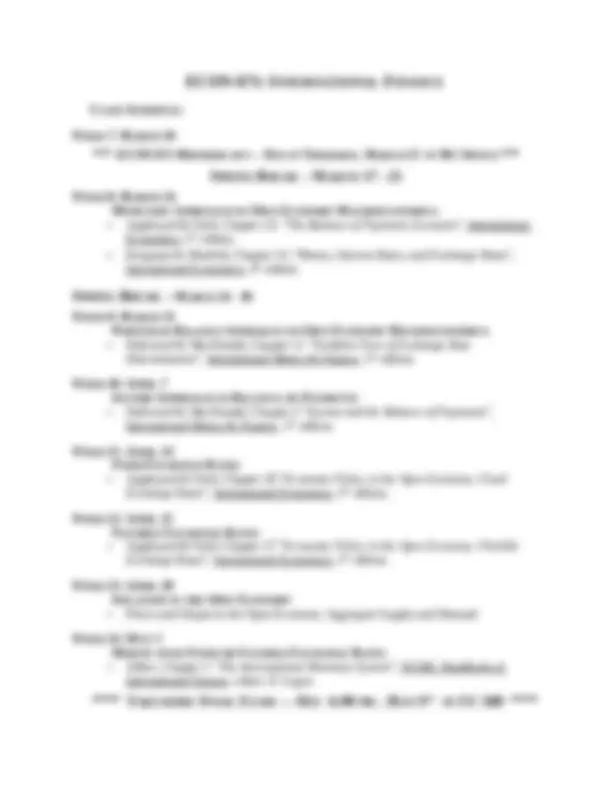



Study with the several resources on Docsity

Earn points by helping other students or get them with a premium plan


Prepare for your exams
Study with the several resources on Docsity

Earn points to download
Earn points by helping other students or get them with a premium plan
Community
Ask the community for help and clear up your study doubts
Discover the best universities in your country according to Docsity users
Free resources
Download our free guides on studying techniques, anxiety management strategies, and thesis advice from Docsity tutors
Material Type: Exam; Class: International Finance; Subject: Economics; University: University of San Francisco (CA); Term: Spring 2003;
Typology: Exams
1 / 3

This page cannot be seen from the preview
Don't miss anything!


E-MAIL: veitchj@ usfca.edu CLASSROOM: LM 351
COURSE DESCRIPTION: The world today has become increasingly international, and it is unlikely that any business or individual is unaffected by international economic forces. This course emphasizes the workings, the institutions, and the dynamics of international financial markets against the backdrop of international macroeconomic policies. It provides preparation for students who wish to understand activities such as foreign currency trading, hedging strategies for international business, the relationship between exchange rate movements and capital flows, and the function of multinational corporations, commercial banks, arbitrageurs, and central banks in these processes. We will try to understand how these elements interact at a theoretical level and identify how the real world often diverges from this ideal. International financial markets are at the intersection of micro markets, the international macroeconomy, and the economics policies of many nations. As a result, this course must blend the techniques of microeconomics (demand/supply, optimization) with the tools of macroeconomics (multiple market interactions, multiplier reasoning). A healthy dose of institutional detail and current policy problems will help focus our analysis. CLASS ATTENDANCE: I place a high value on class attendance. Undoubtedly you will too after the midterm. If you must be absent from class please alert me the week before or leave a message for me at 422-
· Appleyard & Field, Chapter 20 “ The Balance of Payments Accounts ”, International Economics, 3rd^ edition. · Eng, Lees, & Mauer, Chapter 3 “ Balance of Payments Analysis ”, Global Finance, 1st edition. WEEK 2: FEB. 3 FOREIGN EXCHANGE MARKETS · Rivera-Batiz & Rivera-Batiz, Chapter 2 “ Central Banks, Exchange Rate Regimes, and the International Monetary System ”, International Finance and Open Economy Macroeconomics, 2nd^ edition. The Foreign Exchange Market · Rivera-Batiz & Rivera-Batiz, Chapter 3 “ Foreign Currency Regimes in Developing Countries ”, International Finance and Open Economy Macroeconomics, 2nd^ edition. The Foreign Exchange Market WEEK 3: FEB. 10 INTERNATIONAL FINANCIAL MARKETS · Giddy, Chapter 2, “ The Foreign Exchange Market and Eurocurrency Markets ”, Global Financial Markets, 1st^ edition. · Shapiro, Chapter 5, “ The Foreign Exchange Market ”, Foundations of Multinational Financial Management, 3rd^ edition. WEEK 4: FEB 17 INTEREST PARITY RELATIONSHIPS · Shapiro, Chapter 7, “ Parity Conditions in International Finance and Currency Forecasting ”, Foundations of Multinational Financial Management, 3rd^ edition. WEEK 5 & 6: FEB 24, MARCH 3 EXCHANGE RATE FORECASTING · Giddy, Chapter 5, “ Exchange Rates, Interest Rates, and Inflation Rates: An Integrated Framework ”, Global Financial Markets, 1st^ edition. · Giddy, Chapter 6, “ Currency prediction versus Market Efficiency ”, Global Financial Markets, 1st^ edition. WEEK 7: MARCH 10 OFFSHORE BANKING AND INTERNATIONAL FINANCIAL MARKETS · Sundarum, Chapter 3, “ International Financial Markets ”, WG&L Handbook of International Finance, editor, D. Logue. · Rivera-Batiz & Rivera-Batiz, Chapter 8, “ Eurocurrencies and Euromarkets: The Offshore Banking System ”, International Finance and Open Economy Macroeconomics, 2nd^ edition. The Foreign Exchange Market.